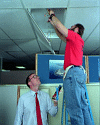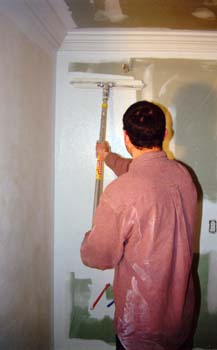 De-lamp overlit areas. In overlit areas, some fluorescent and/or incandescent lamps should be removed to reduce electricity use. In many areas, illumination levels can be reduced by as much as 50 percent while still satisfying minimum lighting requirements. General guidelines for de-lamping fluorescent lamps are: for two-lamp fixtures, remove one lamp in each fixture or both tubes in alternate fixtures; for three-lamp fixtures, remove the lamp in the middle; for four-lamp fixtures, the ballast associated with the two inner tubes should be disconnected. Incandescent lamps can be removed wherever minimum lighting levels still can be maintained without them. Any de-lamping should maintain minimum light levels as required by code and security requirements.
De-lamp overlit areas. In overlit areas, some fluorescent and/or incandescent lamps should be removed to reduce electricity use. In many areas, illumination levels can be reduced by as much as 50 percent while still satisfying minimum lighting requirements. General guidelines for de-lamping fluorescent lamps are: for two-lamp fixtures, remove one lamp in each fixture or both tubes in alternate fixtures; for three-lamp fixtures, remove the lamp in the middle; for four-lamp fixtures, the ballast associated with the two inner tubes should be disconnected. Incandescent lamps can be removed wherever minimum lighting levels still can be maintained without them. Any de-lamping should maintain minimum light levels as required by code and security requirements.

- Keep energy-efficient lamps in stock for replacement. Once efficient lighting is installed, maintenance staff need to ensure that these types of lamps are in stock to avoid re-installation of less-efficient lamps. Where cost-effective, energy-saving fluorescent lamps should replace standard incandescent lamps.
- Clean lighting fixtures. Lamps, fixtures, reflectors, and diffusers should be regularly cleaned because dirty lighting fixtures transmit less light, decreasing lighting efficacy. Caution should be exercised when cleaning all electrical fixtures. The current should be turned off before cleaning fixtures, and fixtures should be thoroughly dry before turning the current back on. Wiring and connections should not be disturbed.

- Clean or paint walls. Walls should be kept clean to maximize the brightness of a room. When new paint is needed, a non-glossy white paint should be selected.
- Check timers on exterior lighting. Timers on exterior lighting should be checked to ensure they are set properly and that the time is set correctly.
For more ways to reduce energy costs, see PHECC's Energy Conservation Measures.
|
TURN OFF UTILITIES: Turn off electricity, gas, propane, and other utilities before starting repairs, cleaning, or installations to avoid accident or injury. BE AWARE OF LEAD-BASED PAINT HAZARDS: Many residences built before 1978 have paint that contains lead, which can pose a serious health hazard if paint, chips, and dust are not handled properly. See the U.S. Environmental Protection Agency (EPA) lead brief before disturbing painted surfaces in homes of this vintage. Follow the HUD "Lead-Safe Housing Rule" for requirements for notification, evaluation and reduction of lead-based paint hazards. BE AWARE OF ASBESTOS HAZARDS: Homes older than 1977 may have building products that contain asbestos such as insulation, high-temperature gaskets, roofing and siding shingles, and vinyl sheet flooring. See the EPA asbestos brief before disturbing such materials. BE AWARE OF MOLD AND MOISTURE HAZARDS: Molds can gradually destroy materials they grow on; can irritate the eyes, skin, nose, throat, and lungs of both mold-allergic and non-allergic people; can cause asthma attacks in people with asthma who are allergic to mold; and can cause other serious health problems. To learn more about preventing and cleaning up mold in homes, see these mold guides and the EPA brief on What to Wear When Cleaning Moldy Areas. |
- Log in to post comments